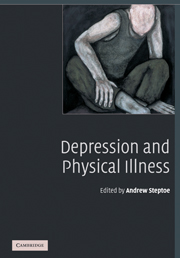Book contents
- Frontmatter
- Contents
- List of contributors
- Preface
- Part 1 Introduction to depression and its determinants
- Part 2 Depression and specific health problems
- 3 Depression and the development of coronary heart disease
- 4 Depression and prognosis in cardiac patients
- 5 The management of depression in patients with coronary heart disease
- 6 Depression and physical disability
- 7 Chronic pain and depression: twin burdens of adaptation
- 8 The interrelationship of depression and diabetes
- 9 Depression and chronic fatigue
- 10 Cancer and depression
- 11 Depression and obesity
- Part 3 Biological and behavioural processes
- Part 4 Conclusions
- Index
- References
3 - Depression and the development of coronary heart disease
from Part 2 - Depression and specific health problems
Published online by Cambridge University Press: 17 September 2009
- Frontmatter
- Contents
- List of contributors
- Preface
- Part 1 Introduction to depression and its determinants
- Part 2 Depression and specific health problems
- 3 Depression and the development of coronary heart disease
- 4 Depression and prognosis in cardiac patients
- 5 The management of depression in patients with coronary heart disease
- 6 Depression and physical disability
- 7 Chronic pain and depression: twin burdens of adaptation
- 8 The interrelationship of depression and diabetes
- 9 Depression and chronic fatigue
- 10 Cancer and depression
- 11 Depression and obesity
- Part 3 Biological and behavioural processes
- Part 4 Conclusions
- Index
- References
Summary
Introduction
This chapter is concerned with the role of depression in the development of coronary atherosclerosis and in the aetiology of coronary heart disease (CHD). Chapter 4 discusses the association between depression and prognosis in patients with existing CHD. The relationship of depression with cardiovascular disease has been a topic of intense research interest over the past 15 years and has driven much contemporary thinking about how physical illness and depression are linked. It has stimulated work on a variety of biological processes that potentially mediate the relationship, including platelet activation [1], vascular inflammation [2], endothelial dysfunction [3], reduced baroreceptor reflex sensitivity [4], sympathovagal imbalance [5] and neuroendocrine dysfunction [6].
The purpose of this chapter is to evaluate the strength and consistency of the association between depression and future CHD, to evaluate the specificity of the relationship, and to describe the biological processes that are probably involved. The chapter is divided into five sections. The first section provides a critical review of existing evidence from longitudinal observational studies that depression and depressive symptoms are associated prospectively with CHD in initially healthy adults. Studies of this topic have generated rather variable results, and so it is worth considering what accounts for the discrepancies. The chapter then questions whether there is a specific link between depression and CHD, or whether comparable associations are present for anxiety and more general psychological distress.
Keywords
- Type
- Chapter
- Information
- Depression and Physical Illness , pp. 53 - 86Publisher: Cambridge University PressPrint publication year: 2006
References
- 8
- Cited by

